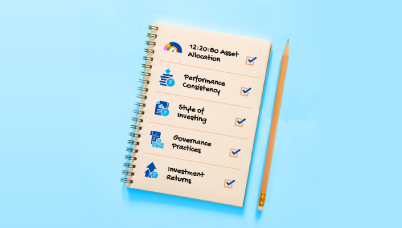Mutual Fund Investment Strategies That You Can Benefit From
Posted On Saturday, Oct 10, 2020
With a surge in new COVID-19 cases every day, India's battle against the pandemic is far from over.
As a result, while many sectors have been unlocked, they are operating at a limited strength and not fully functional.
Amidst, weak earning numbers due to COVID-19 lockdown, the trail P/E of the Nifty 50 index has shot up to over 32x levels, which is certainly an expensive zone.
A high valuation signals that a correction may be on the cards.
The Indian economy was among the worst hit due to the lockdown and thus, while there will be some revival in the coming quarters, rating agencies may still see a major contraction in GDP growth in the FY21. Thus, the markets could be highly volatile in the coming months.
However, that should NOT stop you from investing for your future.
It is important to follow smart investment strategies to mitigate the impact of volatility in your investment portfolio. Here is how you can do it...
1. Hold optimal cash
Firstly, before you start investing ensure that optimal cash, neither too much nor too little, is held. Holding cash comes in handy for your necessary monthly expenses, unforeseen rise in expenses and emergency situations such as job loss, medical emergencies, etc.
Ideally, you should hold cash equal to at least 12 to 24 months of your regular daily expenses (including EMI on loan, if any). This can be held in a savings bank account, or a liquid fund that prioritizes safety and liquidity over returns.
2. Invest in a strategic portfolio of equity funds
When it comes to equity mutual funds, invest in a well-diversified portfolio of equity schemes, which range across different categories and investment styles, based on your investment objective, risk appetite and time horizon to reach your financial goal.
When investing in equity mutual funds, you also need to remember that the investment time horizon for your equity portfolio should be at least around 7 to 8 years (long-term). Remember, while equities have the potential to be rewarding in long term, they are also a high risk investment option.
3. Opt for the SIP mode
Once you have selected right equity schemes to invest in, you could invest a lump sum or via Systematic Investment Plan (SIP). But, in the current market scenario where bouts of high volatility cannot be ruled out and patience of several investors could be tested, choosing an SIP route would prove to be sensible, particularly when addressing long-term financial goals.
SIP is a worthy mode of investing that will help you mitigate the risk involved with its rupee-cost averaging feature, while the endeavour is to compound your hard-earned money.
Here are the 5 benefits of investing via SIP:
? It is light on the wallet
? Enables rupee-cost averaging
? Makes timing the market irrelevant
? Adds to the power of compounding
? Effective medium for planning financial goals
SIP enforces a disciplined approach towards investing and infuses regular saving habits which can prove to be fruitful in your ambition to create wealth.
4. Add debt schemes to improve portfolio stability
Debt schemes are an important part of portfolio diversification, it cannot be entirely ignored. Ideally, according to the 80/20 rule, if 80% of your investments are allocated to equities or equity mutual funds, the rest 20% should be invested in debt schemes dedicated to all your short term goals.
However, the rising spate of defaults and downgrades and the recent episode of winding up of some debt schemes have made debt fund investors wary.
These instances point out that debt funds can expose you to high investment risk if you do not select the scheme sensibly.
In the current scenario where credit risk has amplified, choose debt funds that invest predominantly in government securities as it can offer better safety in terms of credit risk and liquidity.
5. Prefer SWP to take care of cash-flow needs
Since mutual fund performance is subject to market risk, it may not be prudent to opt for a dividend option to earn a regular income.
Instead, park your money in debt funds and use the Systematic Withdrawal Plan (SWP) to withdraw a fixed amount regularly for your cash-flow needs.
Through SWP, you can make regular withdrawals (say monthly, quarterly, half-yearly and annually) of a fixed amount and continue to stay invested.
SWP is especially helpful in planning post-retirement income and expenses.
It will not only provide you with a fixed source of withdrawal but also a disciplined approach to spending. Rupee-cost averaging would work in your favour when you withdraw systematically.
6. Choose STP to smartly shift between equity and debt
Under Systematic Transfer Plan (STP), the lump sum amount you invested in a fund can be systematically transferred in a staggered manner at regular intervals into another mutual fund scheme (as per your preference) of the same mutual fund house.
Suppose you expect the equity market to crash, you can use STP to gradually move your corpus from equity fund to debt fund, or vice versa. This gives you the flexibility to rebalance your portfolio as and when needed.
While placing transactions through SWP or STP, investors must keep in mind the exit load applicable to the fund and tax because these are considered as redemptions.
7. Tactically allocate assets through a multi-asset fund
As an investor, you should note that not all asset classes move in the same direction always, and therefore strategically allocating your investments is important.
To mitigate risk from the possible volatility of one asset class, tactical asset allocation is necessary.
It ensures the correct mix of Equity, Debt, Gold; rather than exposure to a single asset class, which increases the investment risk.
It is prudent for investors with moderately high risk appetite to consider a Multi-Asset Fund of Funds scheme that invests in mainly three asset classes viz. Equity, Debt and Gold. This is what is needed in the current uncertain times.
The investment objective of Multi-Asset Fund of Funds, usually, is to generate modest capital appreciation while trying to reduce risk (by diversifying risks across asset classes) from a combined portfolio of Equity, Debt/Money markets, and Gold schemes.
While including quality debt/fixed income instruments will add some stability, equities can help you generate risk adjusted returns. The inclusion of gold potentially improves further diversification by generally having a negative correlation to equities.
The asset allocation is reviewed regularly in Multi Asset Fund of Funds (sensing the pulse of each asset class and taking calculated risk), and accordingly, necessary portfolio changes are done based on factors like P/E ratio, interest rate movement, macroeconomic outlook, etc.
Thus, a Multi-Asset Fund of Funds helps protect the downside risk and is able to generate risk adjusted modest returns.
In this challenging environment, the above-mentioned investment strategies could help you take informed decisions when it comes to investing in mutual funds.
Make sure you select suitable funds as per your risk appetites to create a portfolio that has the potential to generate wealth.
Editor's note:To know more about investing in a mutual fund write to us at [email protected]
Or give us a missed call at +91-22-68293807 and we will call you back. We will be happy to assist you.
Disclaimer, Statutory Details & Risk Factors:
The views expressed here in this article / video are for general information and reading purpose only and do not constitute any guidelines and recommendations on any course of action to be followed by the reader. Quantum AMC / Quantum Mutual Fund is not guaranteeing / offering / communicating any indicative yield on investments made in the scheme(s). The views are not meant to serve as a professional guide / investment advice / intended to be an offer or solicitation for the purchase or sale of any financial product or instrument or mutual fund units for the reader. The article has been prepared on the basis of publicly available information, internally developed data and other sources believed to be reliable. Whilst no action has been solicited based upon the information provided herein, due care has been taken to ensure that the facts are accurate and views given are fair and reasonable as on date. Readers of this article should rely on information/data arising out of their own investigations and advised to seek independent professional advice and arrive at an informed decision before making any investments.
Mutual fund investments are subject to market risks read all scheme related documents carefully.
Please visit – www.QuantumAMC.com to read scheme specific risk factors. Investors in the Scheme(s) are not being offered a guaranteed or assured rate of return and there can be no assurance that the schemes objective will be achieved and the NAV of the scheme(s) may go up and down depending upon the factors and forces affecting securities market. Investment in mutual fund units involves investment risk such as trading volumes, settlement risk, liquidity risk, default risk including possible loss of capital. Past performance of the sponsor / AMC / Mutual Fund does not indicate the future performance of the Scheme(s). Statutory Details: Quantum Mutual Fund (the Fund) has been constituted as a Trust under the Indian Trusts Act, 1882. Sponsor: Quantum Advisors Private Limited. (liability of Sponsor limited to Rs. 1,00,000/-) Trustee: Quantum Trustee Company Private Limited. Investment Manager: Quantum Asset Management Company Private Limited. The Sponsor, Trustee and Investment Manager are incorporated under the Companies Act, 1956.
Related Posts
-

Do You Need to Update Your KYC/Modify KYC?
Posted On Friday, Apr 26, 2024
New KYC Regulation Effective April 1st 2024
Read More -

Are You Stuck in the Past or Ready for a Secure Future?
Posted On Wednesday, Jun 29, 2022
The ever-growing number of mutual fund schemes on offer has made it challenging for investors to select the best and most suitable one.
Read More -

Received an Increment? Step-up Your SIPs
Posted On Wednesday, Jun 01, 2022
For instance, let’s assume that you have registered for a monthly SIP of Rs 5,000 for a 10-year period and later on try to step-up the SIP at an annual frequency, say by Rs 500. In the first year...
Read More



